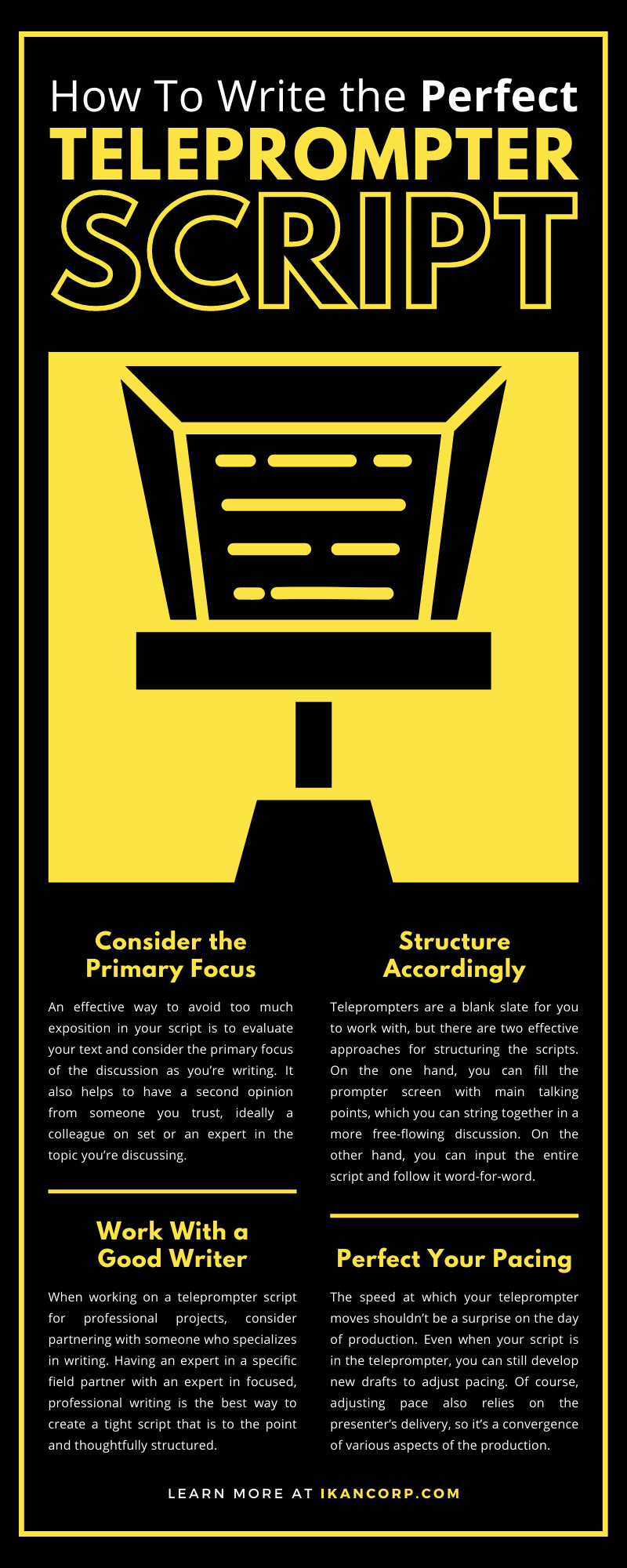 Teleprompters are a consistently reliable production tool for staying on-script without hindering eye contact with your audience, whether in-person or virtual. When working on a video production that involves teleprompters, you may assume the most important aspect is verbal delivery. It goes without saying that delivery is essential when speaking in front of a camera. However, the way the script structure flows on the prompter screen is equally critical, so developing the best strategy starts here.
Teleprompters are a consistently reliable production tool for staying on-script without hindering eye contact with your audience, whether in-person or virtual. When working on a video production that involves teleprompters, you may assume the most important aspect is verbal delivery. It goes without saying that delivery is essential when speaking in front of a camera. However, the way the script structure flows on the prompter screen is equally critical, so developing the best strategy starts here.
If you want to sharpen your skills before jotting down the first draft, use this comprehensive article to learn precisely how to write the perfect teleprompter script. It may sound simple initially, but the information in this guide will show you how detail-oriented you must be to create the ideal script for any production.
Consider the Primary Focus
It’s easy to accidentally create a script that is overstuffed with information. This is understandable when it comes to writing a script on topics you know a lot about. In such situations, it’s not uncommon for filling in details and context to become second nature, even when it isn’t necessary for the audience to understand your discussion. Excessive elaboration is a simple mistake to make, especially if writing isn’t your main focus in video production. Don’t worry; it’s a simple mistake to avoid, too.
An effective way to avoid too much exposition in your script is to evaluate your text and consider the primary focus of the discussion as you’re writing. While certain details may be helpful, are they necessary for getting your point across? In some cases, you may even need more details to successfully discuss your topic, so reassessing the script gives you the opportunity to make those adjustments.
It also helps to have a second opinion from someone you trust, ideally a colleague on set or an expert in the topic you’re discussing. That way, you can better understand how the information sounds to someone who wasn’t involved with the writing. Simply put, find a fresh perspective. Additionally, you must know the essentials of script structure to fine-tune your script with a clearer focus.
Structure Accordingly
Teleprompters are a blank slate for you to work with, but there are two effective approaches for structuring the scripts. On the one hand, you can fill the prompter screen with main talking points, which you can string together in a more free-flowing discussion. This can also help the prompter screen feel less cluttered. On the other hand, you can input the entire script and follow it word-for-word.
Either approach works, so it really comes down to what works best for the project and the presenter. This is why the term “draft” is one of the first you’ll learn when getting more into the writing aspect of production. Drafting scripts multiple times is sometimes necessary, but each rewrite or revision will help you improve your script with precision.
Work With a Good Writer
A strong vision isn’t just necessary for fictional video productions—live streams, news shows, and more productions require a focused visionary at the helm. Thus, when you are the aforementioned visionary, handing off any production duty to someone can cause trepidation, even when it’s necessary. For instance, you should take a detailed approach when searching for a writer because they are creating the voice of your project.
Luckily, when you find the perfect writer for the task, you can have more peace of mind and less stress on your shoulders. Use this principle to choose every team member because when you have driven, creative experts on the set, finding the perfect approach for each project becomes more efficient.
When working on a teleprompter script for professional projects, consider partnering with someone who specializes in writing. Having an expert in a specific field partner with an expert in focused, professional writing is the best way to create a tight script that is to the point and thoughtfully structured. This is especially helpful if you want the teleprompter to display key talking points and fragments of information instead of a full word-for-word script. A good writer will know how to make a big impact with only a few words.
Perfect Your Pacing
The speed at which your teleprompter moves shouldn’t be a surprise on the day of production. In addition, the amount of information on the prompter at any given time shouldn’t be overwhelming to presenters. So, how do you prevent these factors from hindering your production needs? Once again, the solution comes down to the script structure. Before adjusting your script in the prompter, practice with the device to see if all settings are perfect.
Even when your script is in the teleprompter, you can still develop new drafts to adjust pacing. Of course, adjusting pace also relies on the presenter’s delivery, so it’s a convergence of various aspects of the production. If you have a collaborative set, then these aspects can come together exceptionally. This applies to the hardware on set as well.
When looking for a teleprompter for sale, ensuring that it’s fit for your set is invaluable to an efficient production. For example, some teleprompters allow the presenter to use a tablet as the script display. In addition, you can find beams-splitter teleprompters with various camera compatibilities. Exploring the technical specifications of all prompters makes it easier to find a model that will best support your scripting and presenting needs. Even if you can’t test the setup personally, put those responsibilities in the hands of someone on set who you can trust to get the job done professionally.
The Importance of the Perfect Script
Writing the perfect teleprompter script might sound complex, but it will become straightforward once you put these ideas into action. If you’re thinking that writing a teleprompter script seems difficult, remember why it’s so important. The script is your blueprint for the conversation.
Even when it’s not word-for-word, the script is a guide for presenters to use as a tool for directing any discussion. Improvising can be helpful during presentations, but a script helps with retaining focus and avoiding tangents. Moreover, a script helps productions with tight schedules prevent their production from running too long.
As you finish this guide to creating great teleprompter scripts, consider the next steps you can take to bring that quality to your production. Those steps should be easier to follow now that you have this guide to help you find the best approach for your scripting needs.

